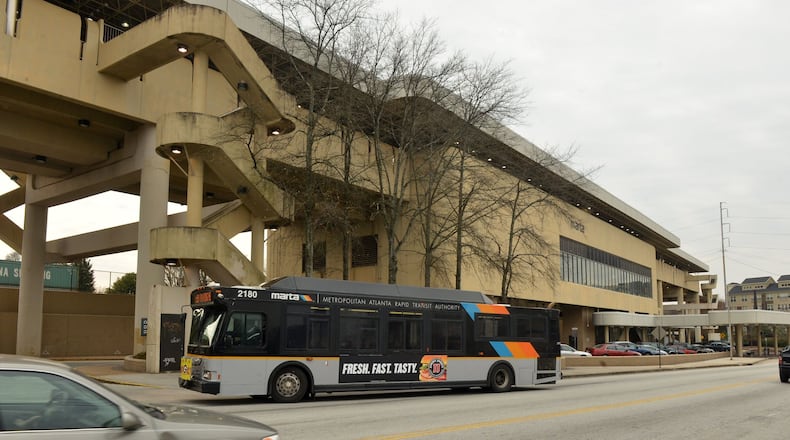Planned MARTA villages
Several walkable urban villages are planned for areas adjacent to MARTA stations:
Arts Center Station: Through August, MARTA will seek proposals for a 6.2-acre site that includes the bus/intermodal terminal, parking and some undeveloped land.
Avondale Station: Columbia Ventures will join with Decatur Downtown Development Authority to build apartments, condos, affordable senior housing units and retail, possibly including a grocery. The lease is nearly finalized. Groundbreaking is expected by early 2016.
Edgewood/Candler Park Station: Invest Atlanta and Columbia Ventures will redevelop this site into about 400 apartments, 20,000 square feet of cultural space, 10,000 square feet of retail and a public park. Final lease negotiations are underway and construction is expected to start by early 2016.
King Memorial Station: Walton Communities has signed a lease with MARTA to build about 350 apartments with street-level retail stores on a 4-acre parking lot. Work is expected to start in 2016.
Chamblee Station: MARTA has been seeking proposals to lease this 2.1-acre former Park and Ride lot across the street from the station since March and will close the proposal process in June.
Oakland City Station: MARTA will be seeking proposals for redevelopment of this 3-acre closed parking lot into a mix of retail and residences later in 2015.
Brookhaven/Oglethorpe Station: About 15 acres of surface parking on the east and west sides of the station are available for redevelopment. Proposals from prospective bidders are due May 28.
MARTA announced Tuesday that it wants to create “walkable developments” at two more stations: Arts Center and Oakland City. The expansion is part of a plan to surround more than a quarter of MARTA rail stations with dense, pedestrian-friendly villages.
When corporate heavyweights like Mercedes-Benz, Coca-Cola and State Farm decide where to locate operations, one key to their decisions is access to mass transit. The thinking is, if workers can walk out the door and step onto a train that takes them directly to work, companies will save time and money — and wear and tear on workers who won’t be stuck on the freeway.
So MARTA has been selling or leasing property at its rail stations to developers who will build villages that in turn will attract droves of transit riders.
Arts Center and Oakland City will be among at least 11 walkable developments coming soon to a rail station near you. The concept is similar to what has already been built at Lindbergh Center, a village development that includes MARTA’s headquarters. The village struggled during the recession but is again on the upswing.
“We have initiatives that are ongoing at stations throughout the system, whether it’s a small project in partnership with the local municipality or we are having conversations with private developers,” said Amanda Rhein, who directs the MARTA Transit-Oriented Development program. “If somebody calls us and says they have an idea for a station, or a project that would attract development to a station, we’re going to be responsive.”
In most cases, the land to be leased or sold is underused parking lots. MARTA has more than 25,000 parking spaces, but less than half are used on a regular basis.
Arts Center station in Midtown is a “more complicated site” compared to many, Rhein said. It would involve construction on a 6.2-acre site that is currently part bus station, part train station, part parking space and part undeveloped land.
Oakland City station has a 3-acre parcel that transit agency officials believe is ripe for redevelopment because of its proximity to the Atlanta Beltline Westside Trail and another potential redevelopment site, Fort McPherson.
MARTA hopes to bring walkable developments to 11 of its 38 rail stations. Lease deals with developers are complete or nearly finished for King Memorial, Avondale and Edgewood/Candler Park stations.
The agency is seeking proposals for Chamblee, Brookhaven and Arts Center and will request proposals for Oakland City station later this year.
Developers are thirsty to build near train stations. They can charge higher rents in exchange for the convenience of transit that’s just steps away.
MARTA, meanwhile, benefits from a boost in ridership. For example, MARTA estimates the King Memorial project could generate up to 500 new transit trips per day; Avondale, up to 787; Edgewood/Candler Park, up to 540.
Chris Leinberger, a Brookings Institution senior fellow who once famously labeled Atlanta the “poster child of sprawl,” spoke at a MARTA Development Day event Tuesday.
Since 2010, 73 percent of the real estate investment in the Atlanta region is in places served by MARTA, Leinberger said.
“You’re evolving from a driveable suburban place…in the metro Atlanta of the 1980s and 1990s, to a metro Atlanta where you have freedom to get around many different ways, including a car,” said Leinberger, who is also president of Locus, an organization of real estate developers and investors who build walkable urban developments. “This is what the market wants.”
Transit access has gone from being an afterthought to a priority for companies that don’t want their workers and products stuck in traffic.
Millennials, younger folks entering adulthood and those up to their early 30s, will make up about half of the nation’s workforce within five years, according to a 2012 workplace report by the University of North Carolina business school. Many are moving to cities where they can walk to work or ride transit.
At the same time, companies are trying to sandwich more workers into open floor-plan buildings. Older buildings being converted for open office spaces typically don’t have enough parking to handle more people. That puts a premium on parking and drives demand for mass transit.
“The reality is that corporate America is sort of changing the way they do business,” said Bill Weghorst, an executive vice president with PM Realty Group.
Dunwoody and Sandy Springs claimed major corporate expansions in State Farm and the U.S. headquarters of Mercedes-Benz, in part because of MARTA rail links.
Kaiser Permanente announced plans last month to locate a technology complex – and create about 900 jobs — in an office building a short walk from the Arts Center station. A Kaiser executive said the company encourages workers as well as members of its health plans to be active, and the company wanted a mix of shops, restaurants and other amenities within walking distance.
NCR and Coca-Cola are among the other companies that have announced or made broad personnel moves with transit in mind.
During the Kaiser announcement last month, Atlanta Mayor Kasim Reed said business expansions and relocations drawn to the city because of transit access have made the conversation about transit development “a nonpolitical conversation. It makes it a decision about whether you want to continue to have the kinds of wins we are having.”
Keep Reading
The Latest
Featured



